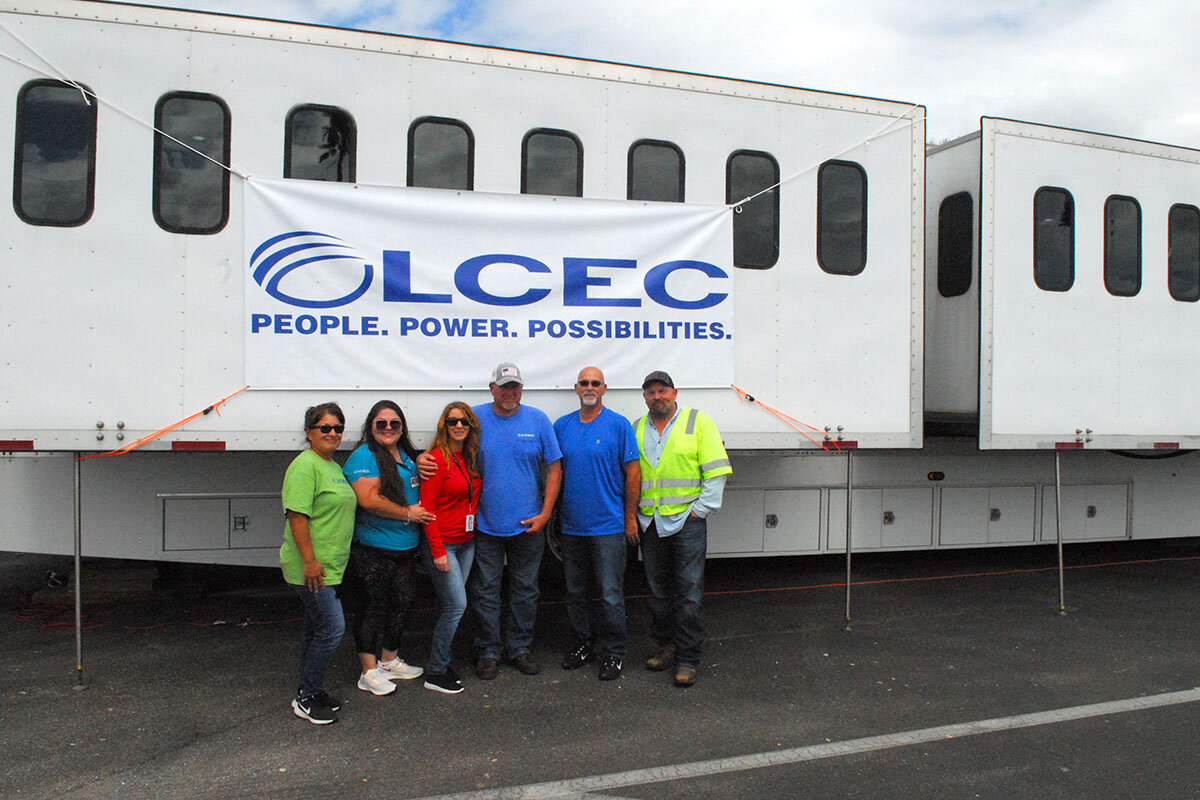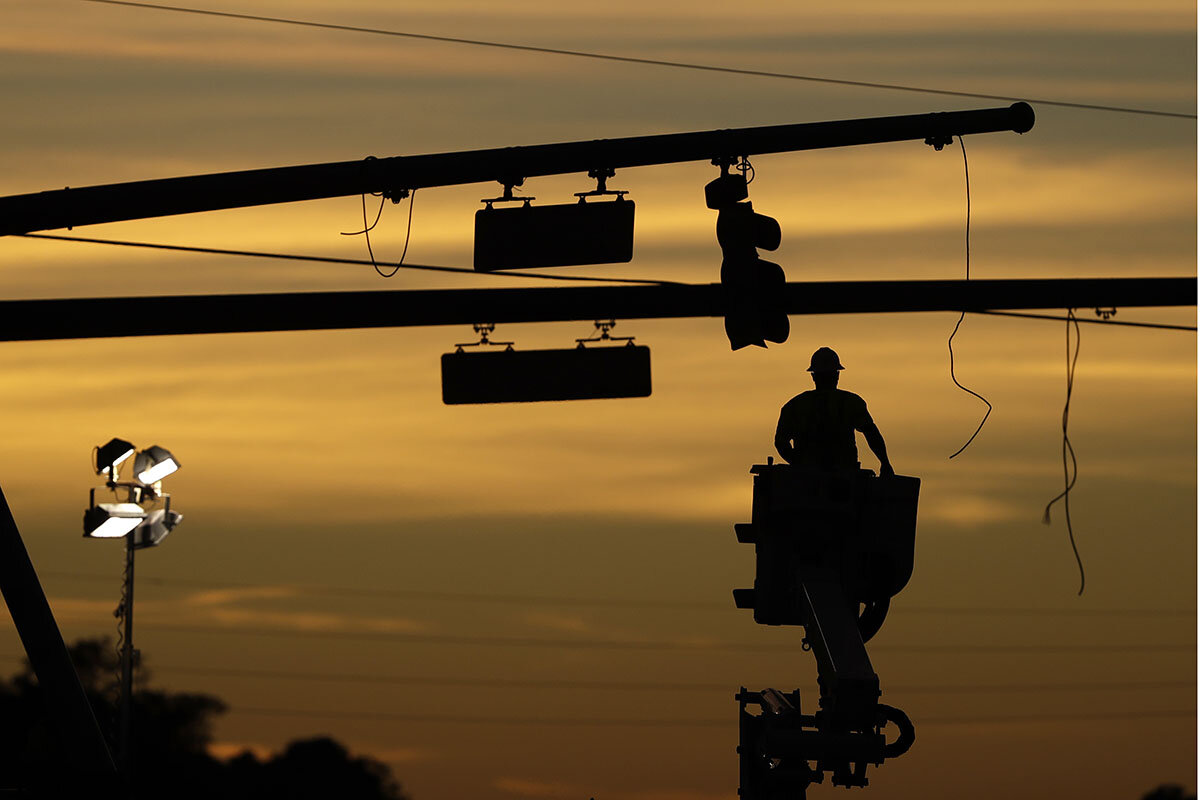‘Pretty remarkable’: How Florida got power back for 2 million after Ian
Loading...
| PINE ISLAND, FLA.
In the parking lot of a Winn-Dixie, next to emergency shelters and stores with windows blown out by Hurricane Ian, Carl Kingsbury, Allen Wagner, and Joe Kardel spend almost three-fourths of their day in an RV-style command center.
They’ve set two plastic tables in the center of the trailer and littered them with maps, multicolored highlighters, unopened pretzel thins, and a gallon bag of granola bars. On the wall is a diagram of the island’s power grid, color-coded in blue and pink. A generator powers the trailer, AC, and a TV in the background showing football – comfort food.
This is how Pine Island, one of the barrier islands pummeled by Hurricane Ian, gets its power back. Mr. Kingsbury, Mr. Wagner, and Mr. Kardel work for the Lee County Electric Cooperative (LCEC) and are coordinating the restoration work on Pine – only accessible since late last week when the state jury-rigged a new bridge to the island.
Why We Wrote This
A story focused onPowerful storms like Hurricane Ian strain the power grids we rely on for everything from homes to schools and traffic lights. In Florida’s case, investments in resilience seem to be paying off.
Two weeks ago, 9 out of 10 homes in Lee County lost power. Since then, more than 91% of the county’s grid is back online, says Mr. Kingsbury, LCEC’s technical training coordinator. An island like Pine, which bore some of Ian’s worst, may have two weeks left before it is entirely back online, and other islands will have to wait longer. But the speed of restoration, matched by other utilities across the state, has been rapid compared with past storms. More than 2 million Floridians lost power two weeks ago. Only about 21,000 are without it now.
Florida spent the past 15 years hardening its electric grid against extreme weather. While a formal analysis will follow, early signs are that it paid off. The state’s utility companies spent a decade and a half swapping wooden poles for concrete and steel ones, undergrounding power lines, and trimming nearby vegetation. This time, most of its citizens got power back within days after a storm that once would’ve disabled the grid for weeks.
No electric system is hurricane-proof – certainly not against a storm that bordered Category 5. And fortifying the grid is a delicate balance of cost and benefit, since citizens have to pay for it in their electric bills or taxes. But as thousands of tree trimmers, repair crews, and other employees like Mr. Kingsbury work 16-to-18-hour days, the state’s investment in its power grid seems to have been good value, says David Dismukes, executive director of Louisiana State University’s Center for Energy Studies.
“I guess some of these resiliency programs are really paying dues right now,” says Professor Dismukes. If taxpayers are left with the bill, he says, “what you want to see is performance outcomes like we did in Florida.”
An impetus named Charley
The 2004 and 2005 hurricane seasons were disastrous for Florida. About 10 named storms hit the state, including Hurricane Charley, a Category 4 storm that followed a similar path to Ian. Millions of people lost power, some of them for weeks.
In response, the Florida Legislature commissioned a report from its Public Service Commission (PSC) on how to harden the grid. It came back in 2007 with several recommendations – including annual storm-preparedness briefings, pole inspections, vegetation management, and undergrounding of some power lines.
State utilities began upgrading their systems, and then – nothing. Florida didn’t have a major hurricane for 10 years. “We’re spending this money to harden the system, but it’s not getting tested,” Tom Ballinger, director of PSC’s Division of Engineering, says he thought at the time.
The test came in 2016 and 2017, when a series of hurricanes crescendoed in Irma, a Category 4 storm that landed in the Florida Keys. A PSC report afterward found the pace of restoration was “fairly rapid” compared with past storms.
During a 2018 workshop, Florida Power & Light, the state’s largest utility, said it took 10 days to restore power to all customers after Hurricane Irma. After Hurricane Wilma 13 years before it took 18 days.
And now, Mr. Ballinger says, “You’re looking at utilities restoring 75% of their customers within three days after a storm. So it is pretty remarkable.”
Comparing two storms is never exact. The time it takes to restore power depends on the strength of the storm, where it hit, the kind of damage, and the number of line workers and tree trimmers working. Even some standard metrics can be misleading, says Ted Kury, director of energy studies at the Public Utility Research Center at the University of Florida.
“We could talk about average restoration times and things of that nature,” says Dr. Kury, a former structuring and pricing analyst at The Energy Authority in Jacksonville, Florida. “But when you’re out of power, that’s little consolation to you.”
Still, some of the same storm-preparedness measures that worked when Hurricane Irma hit seem to be working now. Most damage tends to come from vegetation, like trees, falling on or flying into power lines. A strict vegetation management program now adopted by Florida utilities helped limit the projectiles. Many wooden poles have been replaced by sturdier concrete and steel. More distribution lines are underground, perhaps vulnerable to flooding but safe from wind. Critical infrastructure has also been hardened to prevent accidents (the loss of traffic lights for instance is a leading secondary cause of death after storms).
It’s all been expensive, but state Sen. Joe Gruters says it’s been worth it. “When a third of the state goes down for a day, it’s $1.3 billion in lost activity,” says Senator Gruters, who represents Sarasota and northern Charlotte counties and introduced a 2019 bill to further harden the grid. “There’s nothing more important than having reliable, affordable energy.”
Lines rising again on a storm-tossed island
If the progress is noteworthy, so too is the damage on an island like Pine. About 200 poles were damaged, says Mr. Kingsbury, sitting in the command center. Some are downed next to the road. Some poke out of the ground like snapped toothpicks.
Hardening or no hardening, he says, this is the reality of living in Florida: Parts of the grid will break. “No one can plan for almost a Cat 5 hitting the territory,” says Mr. Kingsbury.
LCEC only arrived on Pine Island last Friday, and started by assessing the damage. More than 500 line workers and tree trimmers are now working there, first to restore the two circuits running north and south – which Mr. Wagner calls the grid’s “backbone.” Once that’s running, they’ll move to critical infrastructure, like medical centers and fire stations, and then to the most people who can get power in the least amount of time.
Step by step, tree trimmers clear the vegetation from the conductors and roadway; line trucks remove, straighten, and reset damaged poles; and line workers in bucket trucks restore the conductor line. Depending on the damage, repairing each pole can take from 10 minutes to 5 hours, says Mr. Kingsbury. He and Mr. Wagner have been working 16 to 18 hours a day for the past two weeks. The line workers, they say, are on a similar clock.
“Every aspect of the company is in motion,” says Mr. Kingsbury.
For line workers since the hurricane, it’s motion and emotion, he adds. More than a dozen LCEC employees lost their homes, and seeing the destruction around them can be wrenching. But despite the damage and despite the hours, getting the power back on is a way to cope. It’s their job to help fix a broken community.
“Linemen say it’s poles and wire,” says Mr. Kingsbury. “No matter where you go it’s poles and wire.”
Editor's note: The order of the names in the photo of LCEC workers has been corrected.








